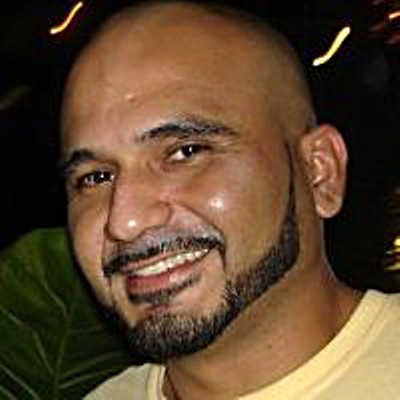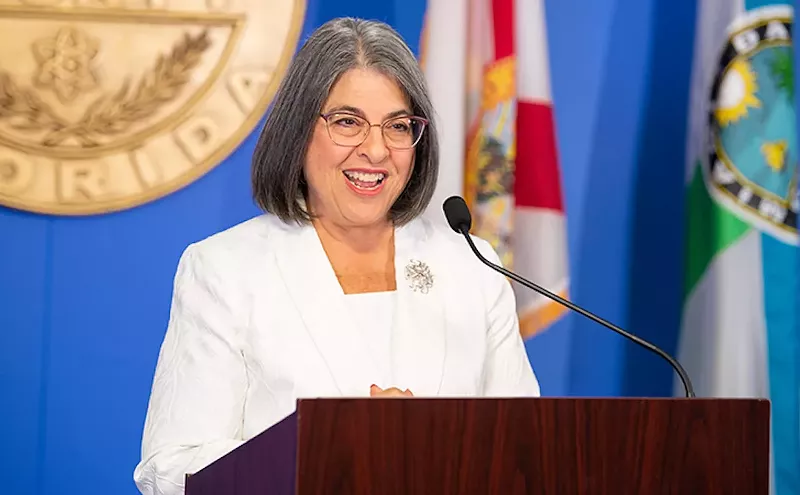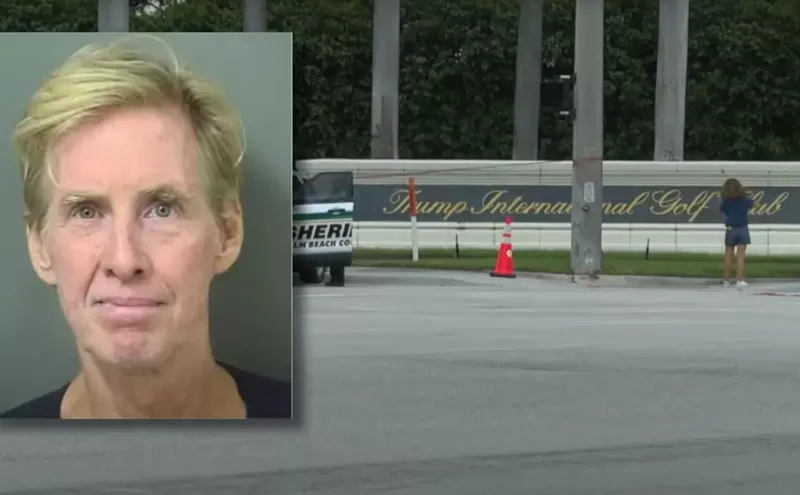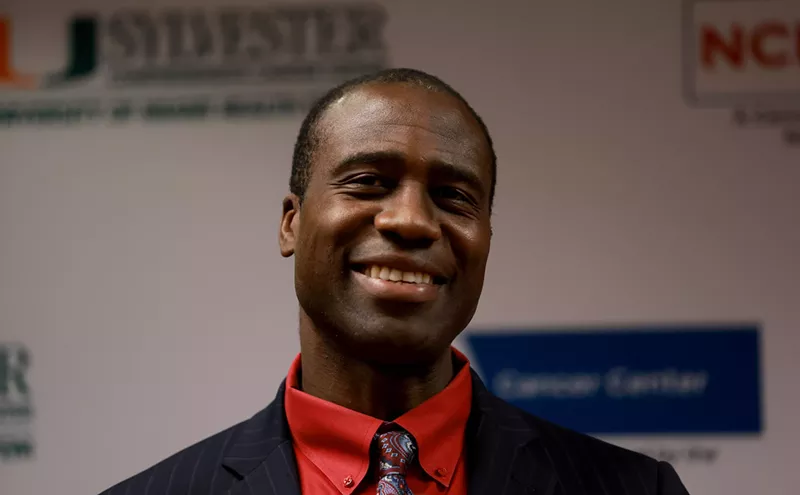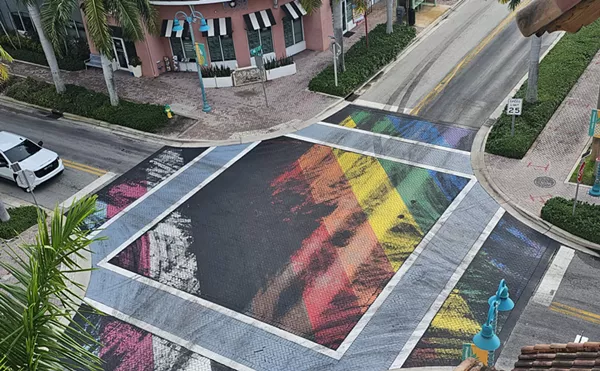The patchy two-lane asphalt road officially known as U.S. Highway 94 is a place of roadside marshes and dense prairies that are home to deer, bobcats, panthers, wild boars, and a plethora of slithery serpents and elusive birds. Dense trees, overgrown grass, and still waters surround the winding path.
On a recent day, about three miles east of the red mailbox, a wood stork fluttered from one side of the road to the other. A hunter in tan camo gear and a bright orange vest exited a pickup truck parked on the roadside and made his way into the brush.
A few hundred yards down the road was the red mailbox. Next to it on the left-hand side was a fresh grave. Nearby was a gravel driveway protected by a towering wood fence.
Behind the barrier, a rusted metal sculpture of what can only be described as a medieval warrior guarded the entrance. A hangman's noose dangled in the wind behind it. The place looked as if it belonged on the set of The Hills Have Eyes, the Seventies horror flick about a lost family that becomes prey for psychotic killers. At the rear of the property, two trailers were connected to each other via a deck, a covered front porch, and a kitchen made from sturdy wood.
A blue-eyed bear of a man wearing a floral print short-sleeve shirt, black Wrangler jeans, and black cowboy boots sat before two computers inside one of the mobile homes. When he stood to greet me, he looked larger than a Florida black bear romping through Big Cypress. He sported a salt-and-pepper mustache and beard, but had a youthful smile.
Meet renaissance swamp man Lucky Cole. He's a storyteller and torchbearer for the lost generations of Loop Road inhabitants, who once numbered more than 200 but today can be counted on eight fingers. He's the de facto custodian of the area's history as a haven for gamblers, mobsters, and other outlaws who have ventured into the Everglades since the Fifties. He has been living on Loop Road for a decade.
On his front porch, letter-size photos of scantily clad and naked women, including Lucky's wife, Maureen, form a collage inside the panes of a massive window panel taken from an old school house. The pictures are evidence of Lucky's favorite hobby-turned-business: shooting photographs of women of all shapes and sizes in alluring poses throughout his mucky playground. More about that later.
First, Lucky wants to show me my overnight accommodations. We walk around the main mobile home to the northwest corner of the compound, where he points to a two-wheel travel trailer that is usually hitched to the back of a pickup truck. "There it is," Lucky cracks. "We call it a redneck guesthouse."
It's way past sunset during one of those unusual cold spells that hits South Florida in early December. Perfect weather for drinking and sharing stories by the campfire. Lucky, his wife, and I stroll off of his front porch and head to a fire pit he has set up near the entrance to his compound.
The couple takes turns sharing snippets of Loop Road's surreal history. From its beginning, the L-shape route has been the site of strange customs and mysterious occurrences. It all began when early pioneering developers hired native Miccosukees to help guide them through the swamp about a century ago. The trail was opened to the public in April 1928. Loop Road, also known as Chevelier Road, was finished shortly thereafter.
Just 200 yards west and across the street from Lucky's wood fence once stood a one-room schoolhouse that was dedicated on July 4, 1924. All that is left is the flat concrete stone with a hole that served as a base for a flagpole. "It was for the children living in the township of Pinecrest," Lucky explains.
Pinecrest is the long-defunct town that was once the hub of Loop Road's commerce. After a brief period as a logging town in the Thirties, Pinecrest came to depend on hunting, front-gigging, and fishing for its livelihood. At one time, it was a bustling little burg of 200 people. But most of them left in 1974, when the federal government established Big Cypress.
Pinecrest was also a place where Chicago crime boss Al Capone allegedly ran a moonshine and gambling lodge in the Twenties. It was supposedly owned by Capone's cousin and burned down in 1927. All that remains is a set of stairs and a foundation, Maureen says. "When I first saw it, I wondered how many people were shot back there. Only the alligators know."
Over the years, scores of tourists and curiosity-seekers have pulled into the strange place Lucky calls home. Visitors have included songwriter Elizabeth Von Trapp, heir to the family that inspired The Sound of Music; and actress Eva Longoria, long before she became a Desperate Housewife. "She is a sweet, pretty little thing," Lucky says while showing me a picture of Longoria he snapped while she was filming Carlita's Secret on his property in September 2002.
We walk up to the outside shower stall made from rough-cut, 80-year-old cypress wood that Lucky salvaged from Sullivan's barbecue restaurant. The place, opened in the Twenties and sold to the government in the mid-Seventies, stood a few yards away from his home.
Lucky and Maureen sometimes bathe here. "I just want you to know we have inside plumbing if you don't want to use the outside shower," he reassures. "We have inside bathrooms, inside showers, and everything, all right."
The stall also serves as a backdrop for the swamp man's, um, models.
At this point, Lucky instructs me to remove my shirt and enter the stall. He snaps several pictures. "Look away," he says. "That's good. You have a nice profile."
Am I about to enter a real-life version of Deliverance?
I put my shirt back on, and the tour progresses to a bathtub stationed next to a dried-out marsh surrounded by the lush landscape. Portable burners powered by two propane tanks sit beneath the tub. Here Lucky pampers his muse and soul mate, Maureen. "Imagine watching the sun go down, sipping a glass of red wine, taking a bubble bath, and you are in the Everglades," Lucky says enthusiastically. "How many people can do that?"
We move on to a three-foot-high sandbox connected to an above-ground swimming pool. Like the stall and the bathtub, this setup is a backdrop. "I like to call it my beach-girl scene," he says.
Just a few steps away is the fanciest outhouse in the Everglades, according to Lucky. He opens a wooden door next to an open safe that appears to be loaded with real dynamite. Inside is a completely tiled bathroom with a working porcelain toilet and sink. On one wall, bookshelves are lined with all kinds of reading material. A guest book filled with signatures sits on the sink. Next to the toilet, in a rack, are several three-ring binders. They contain pictures of Lucky's female models.
One binder is labeled "Legs" in black marker; another is marked "Breasts" in the same manner. Lucky opens the latter. A photograph depicts an apple lodged between two breasts. "Imagine if you were starving," Lucky proffers. "What would you reach for first?"
The exterior of the outhouse is decorated with hanging tin pots and tubs in various sizes, as well as framed eight-by-ten-inch prints of Lucky's subjects.
After a quick tour of a henhouse and greenhouse that were wrecked by Hurricane Wilma, I inquire about the grave next to the mailbox. "It's really a sad story," Lucky intones. "There was, quite a few years ago, a newspaper guy out here who had misquoted me in the article, and that is where he wound up.... You're not going to misquote me, are you?"
Lucky laughs. "There is always a variation to the gravesite story," he says. "One time our daughter Cheyenne came out and she had brought over her new boyfriend. When he asked me who was buried there, I said, öMy daughter's last boyfriend.'"
Louis Herbert Cole II was born July 27, 1947, in Whiteville, North Carolina. Five years later, he and his family moved to Miami Springs, where he grew up and lived until 1994. He graduated from Miami Springs Senior High School and attended Miami-Dade Community College.
When Lucky was around six years old, his uncle Paul M.F. Walker introduced him to the wonders of the Everglades. In 1957, Lucky met his eventual lifelong friend and Loop Road scion Ben Wolfe. "I never got the swamp out of my system," Lucky says.
Wolfe, an Inverness, Florida native who moved to Miami in 1932, worked as a bartender at the Pig and Sax restaurant on the MacArthur Causeway and as a mob bookie. Several years later, Wolfe tended bar at the Happy Hour, a long-gone watering hole located at Douglas Road and Coral Way. It was at a campground on Loop Road where Lucky, then a boy, first met Wolfe. The barkeep was speeding across "the big open prairie" at an amazing clip and kicking up a lot of dirt, Lucky recalls.
The dust cloud got closer. "It was Ben, all right," Lucky says. "He was driving his brand-new 1957 Ford Thunderbird across the prairie at 70 miles per hour."
In the late Seventies and Eighties, Lucky owned a trailer that he kept on Wolfe's Loop Road property, just a mile west from the current Chez Cole. He met Maureen Mabelle Corson in October 1979. One weekend she was washing her muscle car while wearing just a black bikini and wedge sandals near a wine and beer bar on Payne Drive and Ludlam Road in Miami Springs that today is Murphy's. Unbeknownst to Maureen, the bar patrons were taking advantage of the free peep show, according to Lucky. "She was oblivious to what was going on around her," Lucky remembers. "It was just rude. It was sleazy. So I walked over to let her know what these guys were doing."
Lucky would take Maureen, a petite Toronto native, with him on weekends and holidays to Loop Road before they moved there permanently fourteen years ago. It took her some time to adjust to her husband's outdoor fix. "My idea of roughing it was room service," she relates.
They married in 1982.
Lucky bought the three-acre property in 1991 and soon moved his trailer there. "Ben was so upset and angry with me that he didn't speak to me for a year and a half," Lucky recalls. "Yet I had only moved a mile down the road."
When Maureen first saw the land, it was just overgrown brush. "I figure he's getting out of the car to take a leak, because this can't possibly be where we are going to live," she says. She points to the compound's northeast corner. "We walked through this little clearing where an old, burnt-out mobile home was just sitting there."
Maureen didn't bolt, even though the place was a mess and her husband, who has been divorced twice, is something of a flirt. "God made woman last," he says. "I think she's His finest creation."
According to Bill Brownly, one of Lucky's drinking buddies: "He has had more beautiful women in the Everglades than any man I have met in my entire life."
Brownly shares another interesting tidbit about Lucky: He's a notary public who performs marriages. In March 2001, Lucky officiated as Brownly and his wife Luisa renewed their wedding vows. More than 100 guests, most of whom had set up tents to stay overnight, were present at the ceremony, for which Brownly and Lucky had donned black cowboy gear. At one point, a park ranger denounced the groom, calling him an outlaw and a no-good poacher. Lucky drew his nickel-plated, long-barrel .44 handgun and shot.
There were only blanks.
"Lucky just loves putting on a show," Brownly says.
The jolly giant certainly makes no secret of his love for the female form, no matter the shape or size. Lucky's models, photos of whom are displayed on his front porch, in his outhouse, and on his computers, are a menagerie of blonds, brunets, and redheads. Few are stereotypical centerfolds. Nonetheless Lucky takes pride in making them feel beautiful. "Women get in front of that mirror and they see a change every day," Lucky preaches. "Women love to have a history so they can look back on themselves in their photographs."
As a seven-year-old, when most male children are trying to keep the opposite sex out of the clubhouse, Lucky visited a modeling academy in Miami Springs owned by his aunt, Violet Walker. "I'd be over there, and all these gorgeous women would fawn over me," Lucky says. "So I warmed up to the ladies at an early age."
In his late teens, Lucky took up photography as a hobby. One summer in 1967, he and a date pulled over on the side of the road by Monument Lake, located about a mile west of Monroe Station on Loop Road. Back then, Lucky drove a black 1965 Ford Mustang with a red leather interior. "She was a gorgeous strawberry blond," Lucky reminisces. "I photographed her nude on top of the hood. That was the first time I did it. Since then, I've been photographing women in the swamp over the years."
But his pastime became a business only sometime in late 1999, when Maureen decided Lucky's hobby could be put to profitable use. She wants people to understand that her husband is not just some run-of-the-mill sleazy photographer. "We have many clients who don't do nudes at all," Maureen says. "Some who just want a costume setting or something that is really different. Obviously we'll do tasteful nudes, but we're not going to do anything that is in the least bit on the raunchy side."
And Lucky has an extensive album collection of women in the buff frolicking in the muck, in the outdoor shower stall, in the sandbox, and on the front porch. It takes him almost two hours to page through the catalogue of photos saved to the hard drives on his two computers in his office trailer.
In one set of pictures, a short-haired brunet wearing red lingerie and a black feather boa grips a slender tree trunk. She is sandwiched between a topless blond wearing white angel wings, and a topless, curly-haired brunet wearing black angel wings. In other images, a variety of naked women take turns sitting in an oval metal tub.
This collection doesn't include the thousands of photographs Lucky has shot on 35mm film, which he's stored inside old metal ammunition boxes. "It would take us years to look through all my pictures," he says.
On average, Lucky says, he charges his clients $500 for taking between 500 and 800 shots. He and his subject then select the best 100 photos to burn onto a CD and print eight-by-ten images. Lucky estimates that since he started the business, he has photographed at least 100 women, some of whom have traveled from Spain and Italy to have him photograph them. "I'm not bragging," he asserts. "I have tons of material no one sees because my clients don't want me using their photographs."
Lucky proceeds to display some of his photographs on a desktop. In one set, a buxom nude brunet with long curly hair crawls on the muddy ground, wades through the marsh water, and showers in the outdoor stall. Another photo shows a clothed redhead sitting behind Maureen on Lucky's motorcycle. Both ladies are wearing halter tops, dusters, and cowboy hats.
In yet another picture, the same woman is simply staring straight at the camera. "Look at the eyes on her," Lucky says. "She can see right through ya." She is Jacque Wood, an Ohio native who was Lucky's first client. The 33-year-old mother and her family relocated to Naples when she was three years old. In 1997 she moved to Everglades City when she married her husband Thomas. They met Lucky in 2001 when a neighbor told the Woods that Lucky had extra permits for hunting deer in Big Cypress.
"So we called Lucky, and he agreed to let us have the permits," Wood recalls. "We go to Loop Road, pull up the driveway, walk up the porch, and this big huge man holding a Scotch in one hand and a cigar in the other greets us.... I instantly liked him."
The next thing she knew, her beau Thomas suggested that Lucky take alluring photos of her in the swamp for her then-28th birthday. "I was surprised because my husband is very protective," she reveals. "If he doesn't like someone, he will tell me. And I liked the idea because I never had good pictures taken of me."
Wood says she spent more than $800 to have Cole take 240 snapshots. During the entire shoot, she felt completely comfortable. "He was always professional," she says. "I've done a lot of nudes with him. But at my request, he doesn't show them to anyone."
She wanted to be photographed in the Everglades to capture part of her personality, as well as give her husband something he could cherish. "I'd rather be in a swamp buggy than in an office," Wood says. "And the pictures give me something to look back on and say I really looked good in these pictures. As a woman, you don't feel confident all the time about how you look."
Another of Lucky's models is Tracy Reimer, a recent divorcee who in the past year moved from Miami to Maine. She's a doe-eyed hard-body with straight red locks who wears a stars-and-stripes bikini in several of Lucky' s pictorials. Back in February 2002, the 35-year-old single mom found an ad for Lucky's photography in the newspaper. "I had three kids," she says. "I worked hard to get skinny again, and I wanted to show it off a little."
At first, she was intimidated by Lucky's towering, hillbilly appearance. "Here is this huge guy wearing big cowboy boots and a big old belt buckle," Reimer says. "I'm like, Oh my gosh. What did I get myself into? But he made me feel comfortable."
A few weeks later, Reimer trekked to Loop Road, but she was a "little scared." At the time, she was married, but Reimer did not tell her then-husband what she was doing. "I wanted it to be a surprise," she says. "I had called a girlfriend and told her where I was going to be." Upon reaching the gravel driveway, she immediately noticed the rotted bear skull inside a doghouse that greets visitors to Lucky's compound. "That was kind of gross," Reimer says.
At first, she was shy about disrobing. But Maureen made her feel at ease, she says. Since then, Reimer has done four photography sessions with Lucky, including one this past June. "It was more about feeling pretty and to get some attention I thought I was lacking," Reimer says. "But I don't need to do it anymore. I feel a little more secure with who I am."
Late this past December 9, the campfire near the Cole compound's front gate still crackles with life. But the hot orange-blue flames are not the only thing keeping Lucky, Maureen, and their guests warm on a dry, cold night. "It just ain't Scotch if ain't at least twelve years old," Lucky says, savoring a swig of a special-edition eighteen-year-old Glenfiddich.
Then he sucks on his stogy and looks adoringly at his wife. "Maureen is my one true addiction," Lucky muses. "I'll give up anything else you want me to give up, but I am not giving her up."
When Lucky met Maureen in 1979, the photogenic Canadian wasn't ready for his advances. "He was far too good-looking, and all good-looking men I had known had broken my heart," she says, "so the best thing to do was to cut this off before it got started."
Three months later, he was sorting through phone numbers he had collected on napkins, business cards, and matchbooks. "I figured I'd give her one more call before I threw her phone number away," Lucky says. "I asked her if she was ready. We went on our first date and that was it. When people ask me when I fell in love with Maureen, I tell them I was always in love with her. It just took me 28 years to find her."
A few minutes before midnight, the swamp king and queen are ready for bed. Before disappearing into their trailer, Lucky turns off the Budweiser bar sign that hangs from the front porch's awning.


